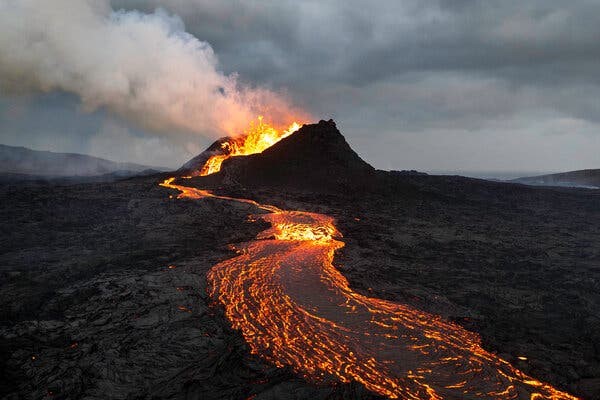By: Eva Li
Volcanoes have always fascinated us. Once revered as the abodes of the gods, some bring forth diamonds from the depths of the earth. But they also spit lava, shake the earth, unleash towering walls of water and repaint the world’s skies. And these days, Iceland’s volcanoes are erupting more than usual.
On Tuesday, the Icelandic Meteorological Office issued a warning, bracing the country for an imminent eruption. This would be the eighth eruption since March of 2021, which includes the awakening of a rugged, volcanic region in its southwestern parts that had been dormant for eight centuries.
“We’re going through a volcanic crisis,” said Matthew J. Roberts, the managing director of the Icelandic Meteorological Office. “This is perhaps the most intense period of volcanic activity affecting an urban environment at the moment.”
The latest episode began on May 29, when a volcano in southwestern Iceland erupted for the fourth time since December. More people had to move from Grindavik, a fishing town of 4,000 that has largely been abandoned since January after lava and earthquakes from previous eruptions split the town in two.
Are eruptions like this normal? Volcanoes usually rest for centuries. The current activity in Iceland is a rare geological event, one that has been gradually transforming the nation’s landscape and daily life. “This is a totally unparalleled and unexpected event,” Dr. Roberts said. “To think that this would happen in my human lifetime, it is remarkable.”
The earliest records of volcanic activity in Iceland date back to the time of its settlement by Norse explores in the late ninth century. More recently, in 2010, the eruption of a volcano in southern Iceland became globally famous for its ash cloud, which disrupted air travel across Europe for several weeks.
On average, Iceland experiences some kind of volcanic activity approximately every three to four years. At the moment, a volcanic eruption is occurring almost every month.While exceptional, it is also normal.
“It’s not unusual to have an eruption where it’s now happening,” said Christopher Kilburn, a professor of volcanology at the University College London. “It’s just been a long time since it last happened.
And to put things in an even broader perspective, there is no evidence of an increase in volcanic activity at the global scale. Seventy to 80 volcanoes erupt every year, and typically, around 20 volcanoes erupt at any one time. This year is on track. “Iceland has eruptions. It’s a volcanic area,” said Ed Venzke, who manages the Smithsonian Institution’s Global Volcanism Program database. A new volcanic zone in Iceland opened in 2021, and it is expected to keep producing small magma eruptions every few months for years, potentially even decades.
“This is a bit of a challenge because you can imagine that 800 years ago, no people were living in that portion of Iceland,” said Luca Caricchi, a geoscientist studying volcanoes at the University of Geneva in Switzerland. “Now, there’s a community. Eruptions can pose local risks, but experts doubt there will be widespread impact.
“We’re able to forecast eruptions with considerable accuracy,” Dr. Roberts said. “And we see they’re only hazardous locally. They don’t pose a problem to the rest of the country.”
Many countries have meteorological national centers that monitor volcanic activity. In Iceland, it’s the Icelandic Meteorological Office. Visit Iceland is also a good source.
The Smithsonian Institution’s Global Volcanism Program explains the world’s latest eruptions and has pages for individual volcanoes, with their individual reports, photos, eruption history and more.
There are also nine volcanic ash advisory centers across the planet, each planning for a certain segment of air space. These centers guide how and where to avoid volcanic ash, ensuring pilots and planes can continue flying without problems.
A spokesperson from the London VAAC, responsible for the northeast Atlantic and Scandinavia, said Iceland hadn’t produced significant volcanic ash, sufficient enough to affect air travel, since 2011.
The last time a volcano affected air travel on a global scale was in April 2010, when the Eyjafjallajokull volcano in Iceland erupted. An eruption of Grimsvotn in May 2011 caused some limited disruption to flights.
Source:
https://www.nytimes.com/2024/07/31/world/europe/iceland-volcano-eruption.html











